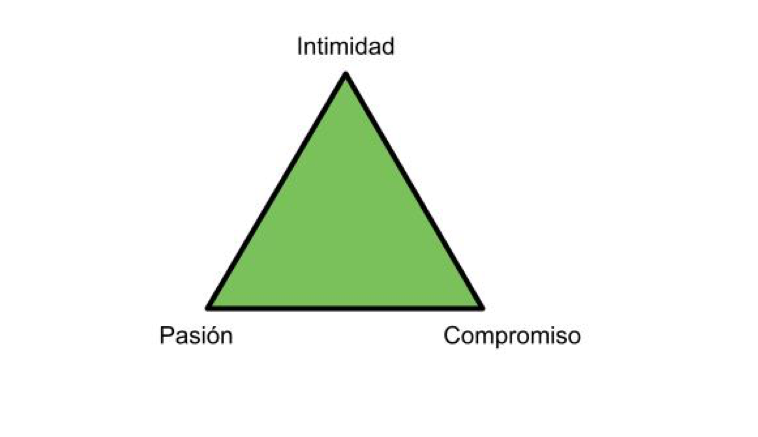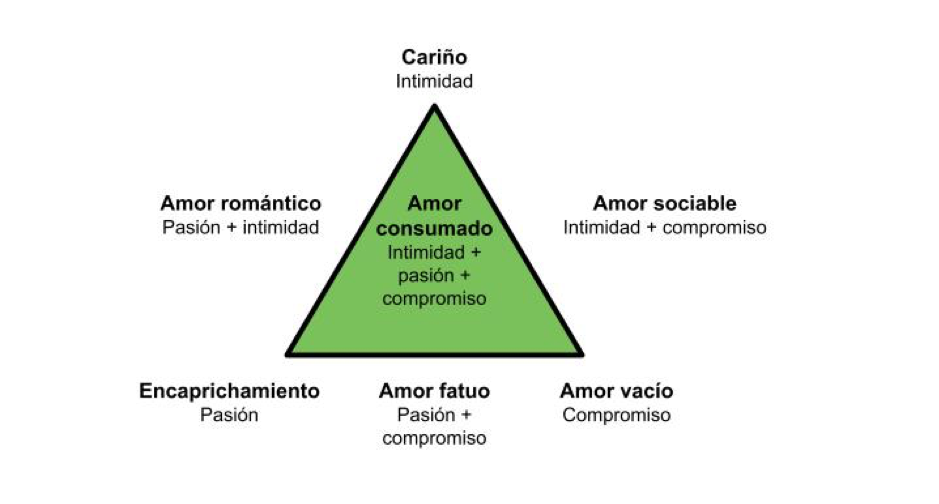
What is Sternberg’s love triangle?
The triangular theory of love is one of the most accepted and widespread theories that aims to explain love in relationships. It was proposed in the late 80s by the American psychologist Robert J. Sternberg, also a professor at Yale University. He is widely recognized for his research, not only for his works focused on love, but also for the study of intelligence or creativity.
Sternberg’s triangle is a very useful theory that allows us to understand this complex feeling that is the basis of our interpersonal relationships. It describes both the elements that make up love, as well as the possible combinations of these when forming our relationships.
What are the pillars of love?
Sternberg points out that love is made up of three fundamental components: intimacy, passion, and commitment. These three elements represent the corners of a pyramid, with intimacy at the highest point and passion and commitment on both sides of the bottom.

Intimacy must be understood as those feelings within the relationship that promote rapprochement, bonding, connection, trust and affection. That is, the knowledge, trust and affection that one person manifests towards another arises from feelings of closeness, bond and relationship, the desire to give and receive, share, etc. Intimacy is usually stable over time and can be controlled in some way.
Passion would be the intense state of desire for union with the other. It refers to physical attraction and the impulse or need to be with the other person and maintain intimate relationships. Passion is usually more unstable and fluctuates frequently.
Commitment refers to the decision or willingness to love another person and maintain that bond in both good and bad times. Like intimacy, it is usually a fairly stable component over time.
From these elements and their different combinations can be explained the different types of love as well as the different stages of a relationship. Likewise, Sternberg assures that a relationship based on a single component will be more complicated to maintain than one that presents two or three components of the triangle.
Types of love according to Sternberg
According to Sternberg’s triangular love scale, there are seven types or forms of love that are defined depending on the weight or role played by each of the components within the relationship:

- Affection: refers to true friendship. There is intimacy between two people, but there is no passion or commitment. The members of the relationship feel close and trust each other, but there is no desire to have intimate relationships or commitment as a couple.
- Infatuation: exists when passion appears, but there is no intimacy or commitment. It is what is commonly understood as “love at first sight” and, generally, they are usually superficial relationships that are short and trivial. It could also be identified with the beginning of a relationship in which there is a desire to have intimate relationships but trust and commitment has not yet developed.
- Empty love: It is characterized by a high commitment, but passion and intimacy are not present. It is typical of long relationships that are maintained due to respect and shared reciprocity.
- Romantic love: There is passion and intimacy, but no commitment. That is, the members of the couple feel attraction and excitement and also have confidence and closeness. It refers to summer loves or very short-lived relationships. Likewise, it can occur at the beginning of a relationship and with the passage of time the commitment develops.
- Sociable or companion love: There is intimacy and commitment, but no passion. It usually occurs in lasting relationships in which the passion is gone, but they enjoy each other’s company and have decided to maintain the bond. In many cases, living together, children and experiences together are the basis for staying together.
- Fatuous or crazy love: There is a large component of passion and a strong commitment, but not intimacy. Generally, the commitment to stay together is motivated for the most part by passion and sexual desire, but not by trust or having things in common.
- Consummate love: It is the complete form of love, also called mature love. It represents the ideal model of love, in which the three components of Sternberg’s triangle are present.
In addition, Sternberg points out that there are other relationships in which no component appears, but that are maintained by other types of variables. These types of relationships are forms of “no love.” The same author points out that it is more difficult to maintain consummate or complete love than to reach it, it may not be permanent. The balance between these three components can change as the relationship progresses, it must be taken care of.
Knowing these three elements of love can help recognize when one of the elements needs to be improved or strengthened, or it can help members of the relationship make a decision.
References
Almeida, A. (2013). Las ideas del amor de R. J. Sternberg: La teoría triangular y la teoría narratica del amor. Familia: Revista de ciencias y orientación familiar, (46), 57-86.
Mazadiego, T. D. J., y Garcés, J. R. N. (2011). El amor medido por la Escala Triangular de Sternberg. Psicolatina, (22), 1-10.
Serrano, G., y Carreño Fernández (1993). La teoría de Sternberg sobre el amor. Análisis empírico. Psicothema, (5), 151-167.
Sternberg, R. J., y Turner, L. (1989). El triángulo del amor: intimidad, amor, compromiso. Barcelona, España: Paidós.
Laura Maymó Gallurt
Psychologist Col. No B-03427








